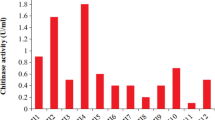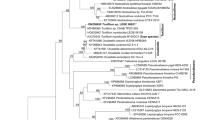Abstract
Marine polysaccharides are being increasingly used in coatings, adhesives, feed stocks, substrates, foods, pharmaceuticals and biotechnological separations, as the gene pools of marine bacteria are tapped by recombinant DNA technology to increase polysaccharide yield. Two examples include polysaccharide adhesive viscous exopolymer (PAVE) genes from a novel marine bacterium, LST, and chitobiose genes from Vibrio vulnificus. Polyclonal and monoclonal antibodies are used to identify, fix and purify important marine polysaccharides. Marine sciences merged with new technologies will generate new adhesives, pharmaceuticals, drag reducers and foods from the sea.
This is a preview of subscription content, access via your institution
Access options
Subscribe to this journal
Receive 12 print issues and online access
$209.00 per year
only $17.42 per issue
Buy this article
- Purchase on Springer Link
- Instant access to full article PDF
Prices may be subject to local taxes which are calculated during checkout
Similar content being viewed by others
References
Sutherland, I.W. 1980. Polysaccharides in the adhesion of marine and freshwater bacteria, p. 329–338. In: Microbial Adhesion to Surfaces R. C. W. Berkeley, J. M. Lynch, J. Melling, P. R. Rutter, and B. Vincent (eds.). Ellis Horwood Publ., Chichester, UK.
Curtin, M.E. 1985. Chemicals from the sea. Bio/Technology 3: 34–37.
Weiner, R.M., Segall, A. and Colwell, R.R. 1985. Characterization of a marine bacterium associated with Crassostrea virginica. J. Appl. Environ. Microbiol. 49: 83–90.
Sandford, P.A., Pittsley, J.E., Knutson, C.A., Watson, P.R., Cadmus, M.C. and Jeanes, A. 1977. Variation in Xanthomonas campestris NRRL B-1459: Characterization of Xanthan Products of Differing Pyruvic Acid Content, p. 192–209. In: Microbial Extracellular Polysaccharides. A. I. Laskin (ed.). Washington, D.C.
Rha, C.K., Rodriguez-Sanchez, D. and Kienzle-Sterzer, C. 1985. Novel applications of chitosan. In: Biotechnology of Marine Polysaccharides, p. 283–312. R. R. Colwell, E. R. Pariser and A. J. Sinskey, (eds.). McGraw Hill, New York.
Fazio, S.A., Uhlinger, D.J., Parker, J.H. and White, D.C. 1982. Estimations of uronic acids as quantitative measures of extracellular and cell wall polysaccharides polymers from environmental samples. Appl. Environ. Microbiol. 43: 1151–1159.
Uhlinger, D.J. and White, D.C. 1983. Extracellular polysaccharide glycocaly in Pseudamonas atlantica. Appl. Environ. Microbiol. 45: 64–70.
Boyle, C.D. and Reade, A.E. 1983. Characterization of 2 extracellular polysaccharides from marine bacteria. Appl. Environ. Microbiol. 46: 392–399.
Rolla, G. 1980. On the chemistry of the matrix of dental plaque, p. 425–439. In: Microbial Adhesion to Surfaces R. C. W. Berkeley, J. M. Lynch, J. Melling, P. R. Rutter, and B. Vincent (eds.). Ellis Horwood Publ., Chichester, UK.
William, C.A. and Chase, M.W. 1967. Methods in Immunology and Immunochemistry. Academic Press, New York.
Kohler, G. 1981. The technique of hybridoma production, p. 285–298. In: Immunological Methods, Vol. 2. I. Lefkovits, and B. Pernis (eds.). Academic Press, New York.
Kennett, R.H., McKearn, T.J. and Bechtol, K.B. 1980. Monoclonal Antibodies. Hybridomas: A New Dimension in Biological Analyses. Plenum Press, New York.
Yelton, D.E., Margulies, D.J., Diamond, B. and Scharff, M.D. 1980. Plasmacytomas and Hybridomas: Development and Application, p. 3–17. In: Monoclonal Antibodies R. H. Kennett, T. J. McKern, and K. B. Bechtol (eds.). Plenum Press, New York.
Zaidi, Bard, R.F. and Tosteson, T.R. 1984. Microbial specificity of metallic surfaces exposed to ambient seawater. Appl. and Environ. Microbiol. 48: 519–524.
Zambon, J.S., Huber, P.S., Meyer, A.E., Slots, J., Fornalik, M.S. and Baier, R.E. 1984. In situ identification of bacterial species in marine microfouling films using an immunoflourescence technique. Appl. and Environ. Microbiol. 48: 1214–1220.
Voller, A., Bidwell, D.C. and Bartlett, A. 1979. The enzyme linked immunosorbent assay (ELISA). A guide with abstracts of microplate applications. Dynatech Laboratories, Inc. Publication 125 p.
Takshio, M. and Okami, Y. 1982. Screening of a dextran sucrose E.C.-24:15. Inhibitor. Agric. Biol. Chem. 46: 1457–1464.
El-Sayed, M.M. 1982. The polysaccharides of the brown seaweed, Turbinaria. Murrayana. Carbohydr. Res. 110: 277–282.
Corpe, W.A. 1970. An acid polysaccharide produced by primary film-forming bacteria. Develop. Ind. Microbiol. 11: 402–412.
Shaw, K.J. and Berg, C.M. 1979. Escherichia coli K12 auxotrophs reduced by the insertion of the transposable element Tn5. Genetics 92: 741–747.
Kleckner, N., Rother, J. and Bostein, D. 1977. Genetic engineering in vivo using translocatable drug resistance elements. J. Mol. Biol. 116: 125–159.
Maniatis, T.M., Fritsch, E.F. and Sanbrook, J. 1982. Molecular Cloning: A Laboratory Manual. Cold Spring Harbor Laboratory, N.Y.
Vieira, J. and Messing, J. The pUC plasmids, and M13mp7-derived system for insertion mutagenesis and sequencing with synthetic universal primers. Gene 19: 259–268.
Clark, W.B. and Gibbons, R.J. 1977. Influence of salivary components and extracellular polysaccharide synthesis from sucrose on the attachment of Streptococcus mutans 6715 to hydroxyapatite surfaces. Infect. Immunity 18: 514–523.
Danielsson, A., Norkrans, B. and Bjornsson, A. 1977. On bacterial adhesion—the effect of certain enzymes on adhered cells of a marine Pseudomonas sp. Botan. Mar. 20: 13–17.
Weiner, R.M. 1985. Microbial films and invertebrate settlement and metamorphosis, p. 283–312. In: Biotechnology of Marine Polysaccharides. R. R. Colwell, E. R. Pariser and A. J. Sinskey (eds.). McGraw Hill, New York.
Soto-Gil, R.W. and Zyskind, J.W. 1984. Cloning of Vibrio harveyii chitinase genes in Escherichia coli, p. 169–177. In: Chitin, Chitosan and Related Enzymes. J. P. Zikakis (ed.). Academic Press, New York.
Corpe, W.A., Matsuuchi, L. and Armbruster, B. 1976. Secretion of adhesive polymers of marine bacteria to surfaces, p. 433–442. In: Proc. 3rd Int. Biodegradation Symp. J. M. Sharpley and A. M. Kaplan, (eds.). Applied Science Publ., London.
Lang, E.R. 1984. New techniques for the isolation and separation of polysaccharides, p. 431–452. In: Biotechnology of Marine Polysaccharides. R. R. Colwell, E. R. Pariser and A. J. Sinskey (eds.). McGraw Hill, New York.
Sanford, P.A. 1985. Applications of marine polysaccharides in the chemical industries. In: Biotechnology of Marine Polysaccharides, p. 431–452. R. R. Colwell, E. R. Pariser and A. J. Sinskey (eds.). McGraw Hill, New York.
Young, L.Y. and Mitchell, R. 1973. The role of microorganisms in marine fouling. Int. Biodeterior. Bull. 9: 105–109.
Meadows, P.S. and Williams, G.B. 1963. Settlement of Spirorbis borealis Daudin larve on surfaces bearing films of microorganisms. Nature 198: 610–611.
Daniel, A. 1955. The primary film in settlement of marine foulers. J. Madras Univ. 25: 89–200.
Fletcher, M. and Marshall, K.C. 1982. Are solid surfaces of ecological significance to aquatic bacteria? p. 199–236. In: Adv. in Microbial Ecol. K. C. Marshall (ed.). Plenum Press, N.Y.
Fletcher, M. and Floodgate, G.D. 1976. The adhesion of bacteria to solid surfaces, p. 101–107. In: Microbiol. Ultrastructure: The Use of the Electron Microscope R. Fuller and D. W. Lovelock (eds.). Academic Press, London.
Fletcher, M. and Floodgate, G.D. 1973. An electron-microscopic demonstration of an acidic polysaccharide involved in adhesion of a marine bacterium to solid surfaces. J. Gen. Microbiol. 74: 325–334.
Colwell, R.R. 1985. Marine polysaccharides for pharmaceutical and microbiological applications, p. 363–376. In: Biotechnology of Marine Polysaccharies. R. R. Colwell, E. R. Pariser and A. J. Sinskey (eds.). McGraw Hill, New York.
Abu, G.D., Weiner, R.M., Bonar, D.B. and Colwell, R.R. 1985. Extracellular polysaccharide production by a marine bacterium. Int. Biodeterior. In press.
Author information
Authors and Affiliations
Rights and permissions
About this article
Cite this article
Weiner, R., Colwell, R., Jarman, R. et al. Applications of Biotechnology to the Production, Recovery and Use of Marine Polysaccharides. Nat Biotechnol 3, 899–902 (1985). https://doi.org/10.1038/nbt1085-899
Issue Date:
DOI: https://doi.org/10.1038/nbt1085-899
This article is cited by
-
The potential of biotechnology for developed and developing countries
MIRCEN Journal of Applied Microbiology and Biotechnology (1986)



